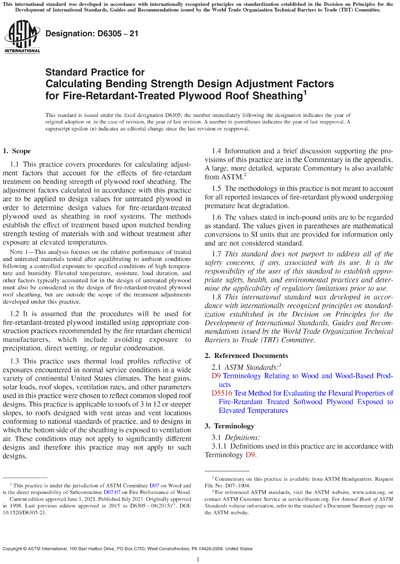Most recent
ASTM D6305-21
Standard Practice for Calculating Bending Strength Design Adjustment Factors for Fire-Retardant-Treated Plywood Roof Sheathing
1.1This practice covers procedures for calculating adjustment factors that account for the effects of fire-retardant treatment on bending strength of plywood roof sheathing. The adjustment factors calculated in accordance with this practice are to be applied to design values for untreated plywood in order to determine design values for fire-retardant-treated plywood used as sheathing in roof systems. The methods establish the effect of treatment based upon matched bending strength testing of materials with and without treatment after exposure at elevated temperatures.
Note 1:This analysis focuses on the relative performance of treated and untreated materials tested after equilibrating to ambient conditions following a controlled exposure to specified conditions of high temperature and humidity. Elevated temperature, moisture, load duration, and other factors typically accounted for in the design of untreated plywood must also be considered in the design of fire-retardant-treated plywood roof sheathing, but are outside the scope of the treatment adjustments developed under this practice.
1.2It is assumed that the procedures will be used for fire-retardant-treated plywood installed using appropriate construction practices recommended by the fire retardant chemical manufacturers, which include avoiding exposure to precipitation, direct wetting, or regular condensation.
1.3This practice uses thermal load profiles reflective of exposures encountered in normal service conditions in a wide variety of continental United States climates. The heat gains, solar loads, roof slopes, ventilation rates, and other parameters used in this practice were chosen to reflect common sloped roof designs. This practice is applicable to roofs of 3 in 12 or steeper slopes, to roofs designed with vent areas and vent locations conforming to national standards of practice, and to designs in which the bottom side of the sheathing is exposed to ventilation air. These conditions may not apply to significantly different designs and therefore this practice may not apply to such designs.
1.4Information and a brief discussion supporting the provisions of this practice are in the Commentary in the appendix. A large, more detailed, separate Commentary is also available from ASTM.2
1.5The methodology in this practice is not meant to account for all reported instances of fire-retardant plywood undergoing premature heat degradation.
1.6The values stated in inch-pound units are to be regarded as standard. The values given in parentheses are mathematical conversions to SI units that are provided for information only and are not considered standard.
1.7This standard does not purport to address all of the safety concerns, if any, associated with its use. It is the responsibility of the user of this standard to establish appropriate safety, health, and environmental practices and determine the applicability of regulatory limitations prior to use.
1.8This international standard was developed in accordance with internationally recognized principles on standardization established in the Decision on Principles for the Development of International Standards, Guides and Recommendations issued by the World Trade Organization Technical Barriers to Trade (TBT) Committee.
Content Provider
ASTM International [astm]






